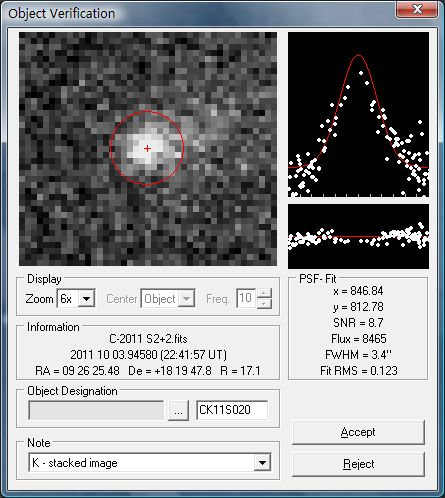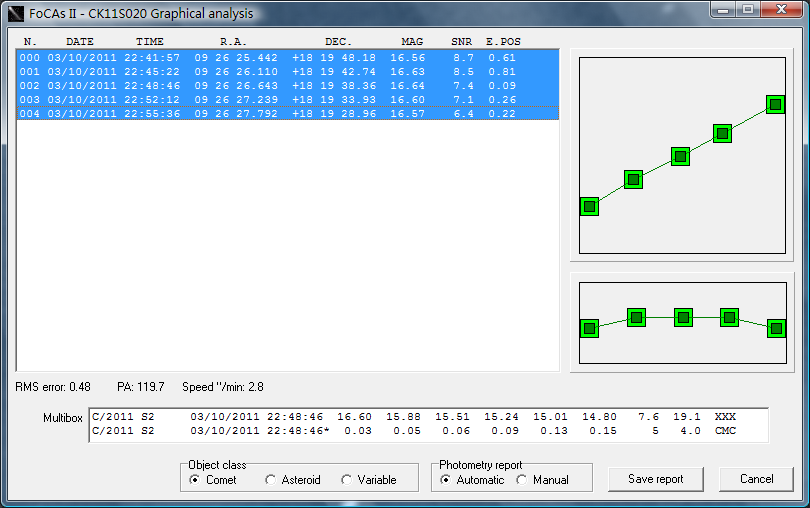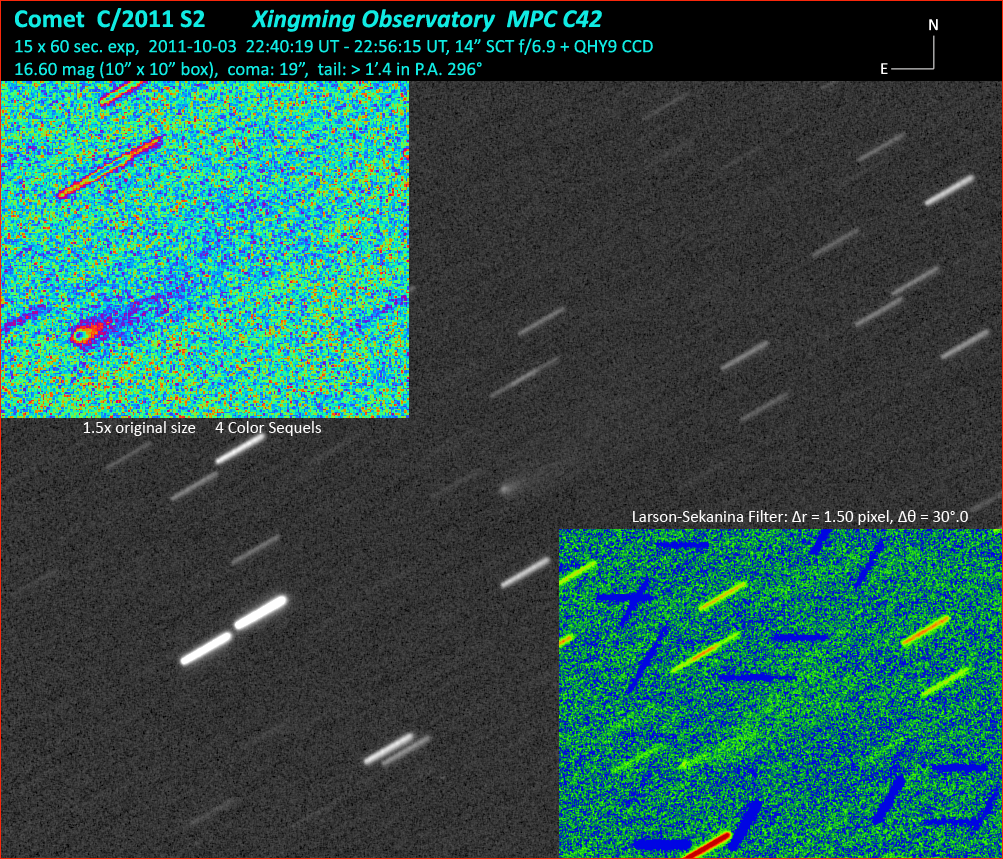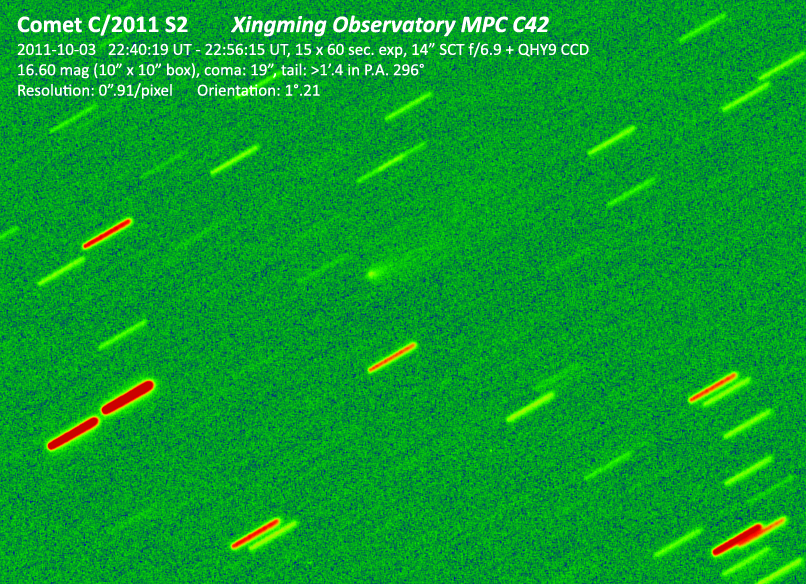C/2011 S2
2011/10/03
2011/10/13
CBET 2852, issued on Oct 03 2011,
announced the discovery of a new comet of 15m.7 in the course of the
Catalina survey through
the 0.68-m Schimdt + CCD, on images obtained by R. A. Kowalski on Sep. 30.48
UT, 2011. The coma is about 15" and the broad tail is 1' long in approximately
P.A. 300°. Initially the comet bore the name "Kowalski" but soon Gareth V.
Williams posted a clarification to cancel the decision so thus far the comet
remains unnamed.
MPEC 2011-T12
comments that the orbit of this object is essentially indeterminate at the
present time. It is possible that this is a short-period comet. Among the
wide range of
possible short-period orbits are orbits that appear similar to P/2006 T1 (Levy).
Initial attempts to link the two apparitions have not been successful.
Further observations are encouraged.
2011 Oct 03
|
The comet shows a curved tail
judging from the stacked image. The trend can be seen even more
manifest in the image filtered by Larson-Sekanina processing.
However, it may well be imperfection of the image due to the
quality of flatfield and dark images.
Mouseover to browse the entire
version without the two specially processed images.
|
|
Pseudo-colors have been applied
to the b/w stacked image so as to present the coma along with
its tail to a somewhat better extent.
|
The following MPC observations were compiled with
coordinates measured in Astrometrica
by UCAC-3 star catalog and photometry by CMC-14 star catalog in R band:
- COD C42
OBS X.Gao, M.-T. Hui
MEA M.-T. Hui
TEL 0.36-m f/6.9 Schmidt-Cassegrain + CCD
NET UCAC-3
CK11S020 KC2011 10 03.94580 09 26 25.44 +18 19 48.2
16.6 N C42
CK11S020 KC2011 10 03.94817 09 26 26.11 +18 19 42.7
16.6 N C42
CK11S020 KC2011 10 03.95053 09 26 26.64 +18 19 38.4
16.6 N C42
CK11S020 KC2011 10 03.95292 09 26 27.24 +18 19 33.9
16.6 N C42
CK11S020 KC2011 10 03.95528 09 26 27.79 +18 19 29.0
16.6 N C42
----- end -----

-
- Gauss curve produced by
Astrometrica with CMC. The total PSF is using
an aperture circle with a radius of
6-pixel around the brightest
pixel. We can see the Gauss curve
in the right is as the computed ideal line and the
real pixels contributed around the ideal line. The Fit RMS,
which inlays under the Gauss curve, is the deviation from the
ideal line.
-
- Photometry result computed with FOCAS II,
which processes images based upon the .LOG file of Astrometrica, by means of
Multibox method:
-
- COD C42
CATALOG: USNO A2.0 / CMC-14 - BAND:
R
10x10 20x20 30x30
40x40 50x50
60x60
SNR SB
COD
OBJECT DATE
TIME +/- +/-
+/- +/- +/- +/-
N FWHM CAT
------------
---------- -------- -----
----- -----
-----
----- ----- ----
---- ---
C/2011 S2
03/10/2011 22:48:46
16.60 15.88
15.51 15.24
15.01 14.80
7.6 19.1
C42
C/2011 S2
03/10/2011 22:48:46*
0.03 0.05
0.06 0.09
0.13 0.15
5
4.0 CMC
FoCAs II - 17/03/2010
www.astrosurf.com/cometas-obs
es.groups.yahoo.com/group/Cometas_Obs
- Interpretation of the FOCAS II table
headings:
-
-
- Fisrt line:
-
- OBJECT,
DATE, TIME: refering to their original meanings respectively
-
- 10x10,
20x20 ... 60x60: the aperture sizes of photometry in term of
rectangle in arcsec that are used to measure an object's magnitude
-
- SNR:
the Signal-to-Noise Ratio for aperture photometry
-
- SB:
stars of faintest magnitude on the images used in data reduction with
the used star catalog in Astrometrica, rather than the stars of faintest
magnitude in the images
-
- COD:
MPC Code of the observatory
-
-
-
- Second line:
-
- +/-:
precisions of measurement
-
- N:
the number of used images for measurement
-
- FWHM:
Full-Width-Half-Maximum of total PSF, relevant to degree of seeing
-
- CAT:
the used star catalog in Astrometrica
-

I try to compute a seemingly appropriate
orbital solution for comet C/2011 F1 (LINEAR) by feeding our own astrometrical
measurements and measurements from other stations and observatories, totally
141 observations (10 or 9 of them rejected in two following corresponding
cases), to FindOrb.
Here come my two reasonable solutions:
[1] Auto-solved mode:
-
Orbital elements:
C/2011 S2
Perihelion 2011 Oct 25.308117 TT = 7:23:41 (JD 2455859.808117)
Epoch 2011 Oct 4.0 TT = JDT 2455838.5 Earth MOID: 0.1497
M 359.97345 (2000.0) P Q
n 0.00124563 Peri. 190.95895 -0.48405469 -0.82719996
a 85.5478070 Node 288.54031 0.82387343 -0.32095783
e 0.9868199 Incl. 17.51663 0.29482810 -0.46122260
P 791.25 M(N) 15.1 K 10.0 q 1.12752518 Q 169.968088
From 85 observations 2011 Sept. 30-Oct. 3; RMS error 0.608 arcseconds
-
Residuals in arcseconds:
110930 703( 1.4- .76+) 111001 J95 .05+ .20- 111002 106 .41+ .39-
110930 703 .53- .36- 111001 J95 .14+ .05- 111002 106( 1.3- .37+)
110930 703( 2.3- .10-) 111001 B86 .03- .13+ 111002 461 .70- .29+
110930 703 .22- .03+ 111001 B86 .00 .04+ 111002 461 .31+ .11-
111001 A17 .44- .15+ 111001 B86 .21+ .26- 111002 461 .14+ .28-
111001 595 .95- .68+ 111001 J95 .27+ .02+ 111002 461 .23- .30+
111001 595 .47- .10- 111001 B86 .18- .15+ 111002 106( 1.1- .06+)
111001 A17 .01+ .18- 111001 H21 .57+ .33+ 111002 510 .75- .18+
111001 A17 .12+ .19+ 111001 H21 .24- .01+ 111002 510 .31- .04-
111001 113 .42+ .03- 111001 H21 .35- .08+ 111002 510 .86- .15+
111001 510 .40- .07+ 111001 H21 .05+ .42- 111002 510 .55- .34+
111001 A71( 1.5- .30-) 111001 H21 .24- .49- 111002 704( 1.2- .87+)
111001 113 .67- .06+ 111001 H21 .30- .30- 111002 704 .48- 1.1+
111001 A71 .68- 1.5+ 111001 H21 .31+ .06- 111002 H17 .00 .08-
111001 A71( 2.3- 1.9+) 111001 H21 .07+ .25- 111002 704( 2.6- 1.4+)
111001 113 .25+ .17- 111001 H17 .56- .83+ 111002 H17( 1.3- 2.1+)
111001 510 .00 .05- 111001 H17 .34- .93+ 111002 H36 .73- .12+
111001 A71 .82- .24+ 111001 H06 .49- .17- 111002 H36 .39- .22-
111001 A71( 1.6- 1.3+) 111001 H17 .02- .22+ 111002 H17 .47- .26-
111001 204 .08- .42- 111001 H06 .74+ 1.1- 111002 H36 .75- .23+
111001 113 .05+ .10- 111001 H06( 1.1+ .11-) 111002 H01 .52+ .12+
111001 A71( 4.0- 3.7+) 111001 H06( 1.0+ .09-) 111002 704( 3.8- 1.7+)
111001 510 .16- .13+ 111001 H06 .37+ .12+ 111002 H17 .59- .40-
111001 204 .17- .44- 111001 H10 .75+ .03+ 111002 H01 .43+ .15-
111001 510 .12+ .11+ 111001 H01 .82+ .04- 111002 H17 .42+ .09-
111001 204 .37- .24- 111001 H10( 1.3+ .15-) 111002 H01 .17+ .07+
111001 B86 .24- .08- 111001 H01 .78+ .09- 111002 H01 .26+ .29+
111001 B86 .17- .03- 111001 H01 .90+ .04- 111003 C42 .59- .22-
111001 B86 .07- .22- 111001 H01 .73+ .06- 111003 C42 .73+ .76-
111001 510 .16- .30+ 111001 G96 .97+ .32- 111003 C42 .08+ .12-
111001 B86 .03+ .01- 111001 G96 .92+ .11+ 111003 C42 .33+ .38+
111001 157 .51+ .19+ 111001 G96 .90+ .29- 111003 C42 .02- .42+
111001 157 .94+ .28- 111001 G96 .68+ .08+
111001 157 .38+ .38- 111002 106 .06- .38-
# State vector (heliocentric ecliptic J2000):
# -0.124481969422 1.168805617857 0.080048863295 AU
# -20.329949020904 -6.355816011461 -6.721335836236 mAU/day
# MOIDs: Me 0.8114 Ve 0.4161 Ea 0.1497 Ma 0.3040
# MOIDs: Ju 1.2084 Sa 1.6910 Ur 1.6343 Ne 2.2862
# Elements written: 4 Oct 2011 8:50:05 (JD 2455838.868113)
# Full range of obs: 2011 Sept. 30-Oct. 3 (100 observations)
# Find_Orb ver: Oct 11 2010 13:08:42
# Perturbers: 00000000 (unperturbed orbit)
# Tisserand relative to Earth: 2.86633
# Tisserand relative to Jupiter: 1.31227
# Tisserand relative to Neptune: 0.87207
[2] With constraint e = 1:
Orbital elements:
C/2011 S2
Perihelion 2011 Oct 25.213819 TT; Constraint: e=1
Epoch 2011 Oct 4.0 TT = JDT 2455838.5 Earth MOID: 0.1523
q 1.13023030 (2000.0) P Q
M(N) 15.1 K 10.0 Peri. 190.84903 -0.48424052 -0.82713416
Node 288.65692 0.82359203 -0.32088605
e 1.0 Incl. 17.52111 0.29530879 -0.46139052
From 85 observations 2011 Sept. 30-Oct. 3; RMS error 0.607 arcseconds
Residuals in arcseconds:
110930 703( 1.4- .78+) 111001 J95 .05+ .20- 111002 106 .40+ .39-
110930 703 .51- .34- 111001 J95 .13+ .05- 111002 106( 1.3- .37+)
110930 703( 2.3- .08-) 111001 B86 .03- .13+ 111002 461 .71- .28+
110930 703 .21- .04+ 111001 B86 .00 .05+ 111002 461 .29+ .11-
111001 A17 .44- .15+ 111001 B86 .21+ .26- 111002 461 .13+ .28-
111001 595 .95- .68+ 111001 J95 .27+ .02+ 111002 461 .25- .30+
111001 595 .47- .10- 111001 B86 .19- .15+ 111002 106( 1.2- .05+)
111001 A17 .01+ .18- 111001 H21 .57+ .33+ 111002 510 .76- .17+
111001 A17 .12+ .19+ 111001 H21 .25- .01+ 111002 510 .33- .04-
111001 113 .43+ .03- 111001 H21 .35- .08+ 111002 510 .88- .15+
111001 510 .39- .07+ 111001 H21 .05+ .42- 111002 510 .57- .34+
111001 A71( 1.5- .30-) 111001 H21 .24- .49- 111002 704( 1.2- .87+)
111001 113 .66- .06+ 111001 H21 .30- .30- 111002 704 .49- 1.1+
111001 A71 .68- 1.5+ 111001 H21 .31+ .06- 111002 H17 .01- .08-
111001 A71( 2.3- 1.9+) 111001 H21 .07+ .25- 111002 704( 2.6- 1.4+)
111001 113 .25+ .17- 111001 H17 .56- .83+ 111002 H17( 1.4- 2.1+)
111001 510 .00 .05- 111001 H17 .35- .93+ 111002 H36 .75- .11+
111001 A71 .82- .24+ 111001 H06 .49- .17- 111002 H36 .40- .22-
111001 A71( 1.6- 1.3+) 111001 H17 .03- .22+ 111002 H17 .48- .26-
111001 204 .08- .42- 111001 H06 .74+ 1.1- 111002 H36 .76- .23+
111001 113 .05+ .10- 111001 H06( 1.1+ .10-) 111002 H01 .51+ .12+
111001 A71( 4.0- 3.7+) 111001 H06( 1.0+ .09-) 111002 704( 3.8- 1.7+)
111001 510 .16- .13+ 111001 H06 .36+ .12+ 111002 H17 .60- .40-
111001 204 .17- .44- 111001 H10 .74+ .04+ 111002 H01 .42+ .15-
111001 510 .12+ .11+ 111001 H01 .81+ .04- 111002 H17 .41+ .09-
111001 204 .37- .24- 111001 H10( 1.3+ .15-) 111002 H01 .16+ .07+
111001 B86 .24- .08- 111001 H01 .78+ .08- 111002 H01 .26+ .28+
111001 B86 .17- .03- 111001 H01 .89+ .04- 111003 C42 .56- .23-
111001 B86 .08- .22- 111001 H01 .72+ .05- 111003 C42 .76+ .77-
111001 510 .17- .30+ 111001 G96 .96+ .32- 111003 C42 .12+ .13-
111001 B86 .03+ .01- 111001 G96 .91+ .12+ 111003 C42 .37+ .38+
111001 157 .51+ .19+ 111001 G96 .90+ .29- 111003 C42 .01+ .42+
111001 157 .94+ .28- 111001 G96 .67+ .08+
111001 157 .38+ .37- 111002 106 .07- .38-
# State vector (heliocentric ecliptic J2000):
# -0.127183234640 1.171217736955 0.080243618590 AU
# -20.360380014630 -6.421701632900 -6.738631533044 mAU/day
# MOIDs: Me 0.8141 Ve 0.4187 Ea 0.1523 Ma 0.3025
# MOIDs: Ju 1.2294 Sa 1.7619 Ur 1.7290 Ne 2.6677
# Elements written: 4 Oct 2011 9:04:27 (JD 2455838.878090)
# Full range of obs: 2011 Sept. 30-Oct. 3 (100 observations)
# Find_Orb ver: Oct 11 2010 13:08:42
# Perturbers: 00000000 (unperturbed orbit)
# Tisserand relative to Earth: 2.86746
# Tisserand relative to Jupiter: 1.25707
# Tisserand relative to Neptune: 0.52292
In celestial mechanics, there is a criterion
called Tisserand's Criterion to determine whether or not an observed orbiting
body is the same as a previously observed orbiting one, as a consequence of
Tisserand's relation. For a small body with
semimajor axis $a$, eccentricity $e$, and inclination $i$, with respect to a
massive perturbing body with semimajor axis $a_P$, the parameter is definded by
the following formula:
$T_P=\frac{a_P}{a} +
2\left [ \frac{a}{a_P} (1-e^2)\right ]^\frac{1}{2} \cos i $
According to MPC 75514, the elements of
P/2006 T1 (Levy) at the same epoch as the above two solutions are as
follows:
Epoch (TT/JD) T (TT/JD) Peri. Node Incl. e q a Epoch (TT)
2455838.50000 2455939.0245593 179.62257 279.74449 18.26280 0.6679327 1.0073994 3.03372 2011/10/04.00
Compared to what we have about 2011 S2, we
will find no much difficulty in identifying some similarities in the orbital
elements between 2011 S2 and P/2006 T1 (Levy). In that I do not possess many
observations of P/2006 T1, I turn to respectively analyze their Tisserand's
parameters with respect to all the planets from the innermost Mercury to the
outermost Neptune in the solar system. To achieve the target, I myself wrote a
routine in IDL to carry out the
calculations for me. All of the three orbital solutions for comet 2011 S2 of
mine and from MPEC 2011-T12 were taken into the calculation. Here come the
results as follows:
|
Comet |
$T_{Mercury}$ |
$T_{Venus}$ |
$T_{Earth}$ |
$T_{Mars}$ |
$T_{Jupiter}$ |
$T_{Saturn}$ |
$T_{Uranus}$ |
$T_{Neptune}$ |
Source |
|
2011 S2 |
4.6187111 |
3.3787994 |
2.8736290 |
2.3280082 |
1.2596546 |
0.9283308 |
0.6553122 |
0.5237470 |
MPEC 2011-T12 |
|
4.6087911 |
3.3715426 |
2.8674569 |
2.3230082 |
1.2569491 |
0.9263370 |
0.6539048 |
0.5226222 |
FindOrb |
|
4.5927198 |
3.3649310 |
2.8663322 |
2.3304379 |
1.3121666 |
1.0342053 |
0.8757625 |
0.8721799 |
FindOrb |
|
2006 T1 |
4.0845766 |
3.1331422 |
2.7915469 |
2.4967171 |
2.7946545 |
3.9538304 |
6.8999819 |
10.371726 |
MPC 75514 |
We can learn from the table that the
Tisserand's parameters with respect to the four terrestial planets are close to
each other, yet from Jupiter, the Tisserand's parameters of the two bodies start
to digress further and further, based upon the assumption that if the orbital
solutions are reliable or relatively close to the fact to be proven by further
observations. I boldly venture to guess that perhaps the two bodies have some
possibilities to be linked to each other, however, this statement need to be
meticulously treated without support from more evidence. If it happens to be
correct, it means that the comet has been driven out of the Jupiter-family since
a close encounter with some terrestial planet.
As said, further observations of comet 2011 S2
are intensely encouraged so as to smooth the noise.
Copyright © Man-To
Hui
2011/10/04
As more observations
have been obtained,
MPEC 2011-T39
publicized an updated orbital solution for 2011 S2. I used JPL to generate its
orbital elements at Epoch 2455880.5 (2011 Nov 15.0 CT) as follows:
*******************************************************************************
Target body name: C/2011 S2
# obs: 150 (7 days) data arc: 2011-Sep-30 to 2011-Oct-07
Residual RMS= .63681
*******************************************************************************
EC= 9.066346719791114E-01 QR= 1.109950500254332E+00 IN= 1.755092011502044E+01
OM= 2.878264558173418E+02 W = 1.923106502381481E+02 Tp= 2455860.951143381651
N = 2.404512826156002E-02 MA= 4.700547647537690E-01 TA= 2.220893578515344E+01
A = 1.188825149316681E+01 AD= 2.266655248607930E+01 PR= 1.497184777240375E+04
*******************************************************************************
Coordinate system description:
Ecliptic and Mean Equinox of Reference Epoch
Reference epoch: J2000.0
xy-plane: plane of the Earth's orbit at the reference epoch
x-axis : out along ascending node of instantaneous plane of the Earth's
orbit and the Earth's mean equator at the reference epoch
z-axis : perpendicular to the xy-plane in the directional (+ or -) sense
of Earth's north pole at the reference epoch.
Symbol meaning [1 AU=149597870.691 km, 1 day=86400.0 s]:
JDCT Epoch Julian Date, Coordinate Time
EC Eccentricity, e
QR Periapsis distance, q (AU)
IN Inclination w.r.t xy-plane, i (degrees)
OM Longitude of Ascending Node, OMEGA, (degrees)
W Argument of Perifocus, w (degrees)
Tp Time of periapsis (Julian day number)
N Mean motion, n (degrees/day)
MA Mean anomaly, M (degrees)
TA True anomaly, nu (degrees)
A Semi-major axis, a (AU)
AD Apoapsis distance (AU)
PR Orbital period (day)
Also, I acquired orbital elements of comet
P/2006 T1 at the same Epoch in JPL:
*******************************************************************************
Target body name: P/2006 T1 (Levy)
# obs: 314 (60 days) data arc: 2006-Oct-02 to 2006-Dec-01
Residual RMS= .72686
*******************************************************************************
EC= 6.679022959202969E-01 QR= 1.007416008064483E+00 IN= 1.826274662902490E+01
OM= 2.797401704965575E+02 W = 1.796208748878264E+02 Tp= 2455938.715627640951
N = 1.865475768733755E-01 MA= 3.491400157274438E+02 TA= 2.980565533697751E+02
A = 3.033492841681026E+00 AD= 5.059569675297568E+00 PR= 1.929802606036316E+03
*******************************************************************************
Coordinate system description:
Ecliptic and Mean Equinox of Reference Epoch
Reference epoch: J2000.0
xy-plane: plane of the Earth's orbit at the reference epoch
x-axis : out along ascending node of instantaneous plane of the Earth's
orbit and the Earth's mean equator at the reference epoch
z-axis : perpendicular to the xy-plane in the directional (+ or -) sense
of Earth's north pole at the reference epoch.
Symbol meaning [1 AU=149597870.691 km, 1 day=86400.0 s]:
JDCT Epoch Julian Date, Coordinate Time
EC Eccentricity, e
QR Periapsis distance, q (AU)
IN Inclination w.r.t xy-plane, i (degrees)
OM Longitude of Ascending Node, OMEGA, (degrees)
W Argument of Perifocus, w (degrees)
Tp Time of periapsis (Julian day number)
N Mean motion, n (degrees/day)
MA Mean anomaly, M (degrees)
TA True anomaly, nu (degrees)
A Semi-major axis, a (AU)
AD Apoapsis distance (AU)
PR Orbital period (day)
I wrote an improved
routine to perform the
calculations of the Tisserand's parameters with respect to different planets.
The results are as follows:
| Comet |
$T_{Mercury}$ |
$T_{Venus}$ |
$T_{Earth}$ |
$T_{Mars}$ |
$T_{Jupiter}$ |
$T_{Saturn}$ |
$T_{Uranus}$ |
$T_{Neptune}$ |
Source |
|
2011 S2 |
4.4911973 |
3.3225379 |
2.8581554 |
2.3754728 |
1.6538106 |
1.7004738 |
2.2473768 |
3.0352627 |
JPL |
| 2006 T1 |
4.0845779 |
3.1331517 |
2.7915698 |
2.4967429 |
2.7944679 |
3.9409660 |
6.8877047 |
10.361610 |
JPL |
As seen, there is still no strong evidence
indicating that 2011 S2 and 2006 T1 is the same body in two different
apparitions. The only thing we now can do is to await more observations of 2011
S2 with a greater arc.
Copyright © Man-To
Hui
2011/10/12
Feel free to e-mail
me with any doubts or questions.
Top
Back...
-- Zurück...
Home



